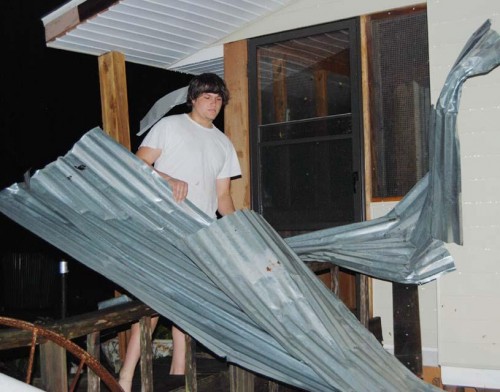
Tornado rips across East Houma street
January 2, 2008Brian Champange
January 7, 2008Cal Kingsmill has vivid memories his first experience with hand-carved wildfowl decoys.
“My father used to take me fishing, and I remember being about 5 years old and pulling them (wooden ducks) around by a string in the water when I was around 5 years old,” the New Orleans native recalled. “I was just really fascinated with them.”
But the feeling wasn’t fleeting.
Kingsmill’s affinity eventually blossomed into a lifelong love affair that manifests itself in a decoy-carving career that spans more than 30 years.
His craftsmanship will be on display at “Birds of a Feather: Wildfowl Carving in Southeast Louisiana,” an exhibit that will feature contemporary carvings at The Historic New Orleans Collection’s Williams Research Center from Jan. 15 through April 20.
The exhibition, which will include the works of Jimmie Vizier of Cut Off and Tan and Jett Brunet of Lafourche Parish, will be open to the public Tuesday through Saturday between 9:30 a.m. and 4:30 p.m.
“I’m definitely excited because I love every bit of this (carving),” Kingsmill said. “There will be a lot of good carvers there – I won’t be the best by far.”
Traditional working decoys from Louisiana date back to the 1800s. “Working ducks” served a functional purpose, as they helped hunters attract prey.
It wasn’t until a century later that factory decoys (made from machine-duplicated wood or plastic) made hand-carved decoys less economically competitive.
Nonetheless, the skill and artistry of hand-carving eventually reemerged, but it transitioned from folk art to fine art.
“Probably around 1955 and later was when plastic decoys took over for working purposes, but a lot of people still wanted to carve and they’d make them (wooden waterfowl) to look fancier and fancier,” explained Pearlington, Miss. resident Bill Hanamon, who will also have work on display at the exhibit. “Now carving has gone way beyond being just a craft.”
Carving has been Hanamon’s source of income for more than 40 years. Past projects have taken him as long as six months to complete.
“I sold a whole still-life for $10,000 that had a lot of elements in it,” Hanamon said. “It contained a (carved) shooting bag for dead birds, a hunting jacket and duck call.”
Hanamon accommodates people’s requests for different species of waterfowl, but is provided carte blanche to create the positioning of each carving.
He tries to exclusively work with cypress-root wood.
“It (cypress) is already dead wood and can usually be gathered after a storm,” Hanamon said. “It’s the type of wood traditional woodcarvers use.”
“Traditional” is an operative word with contemporary carvers.
“This exhibit offers a lot more than a simple look at decoys,” Hanamon said. “These (waterfowl) carvings are an integral part of our coastal history. The same people that used to create carving decoys were probably trappers, hunters and maybe shrimpers who relied on the decoys for their livelihood. They needed them.”
The exhibit will offer a melange of artistic interpretations.
“The thing that makes them all unique is the fact that they were all carved by hand and each bird has a distinct style to it,” Kingsmill said. “They are very convincing looking. When you look at the old bird and compare them to the modern birds, and if you look at the birds from each region, you can see the personal styles in each carving. The bayou birds are different than the Mississippi River birds. That is what intrigues me the most.”
Along with the aesthetic beauty.
“These carvers used a lot of imagination and were really poetic in turning something they saw in nature into a work of art,” Kingsmill added.
Admission to “Birds of a Feather: Wildfowl Carving in Southeast Louisiana” is $6 for adults and free for children and students.
Local decoys from Jimmie Vizier of Cut Off and Tan and Jett Brunet of Lafourche Parish will also be on display.
For more information, visit www.hnoc,org or call (504) 523-4662.







